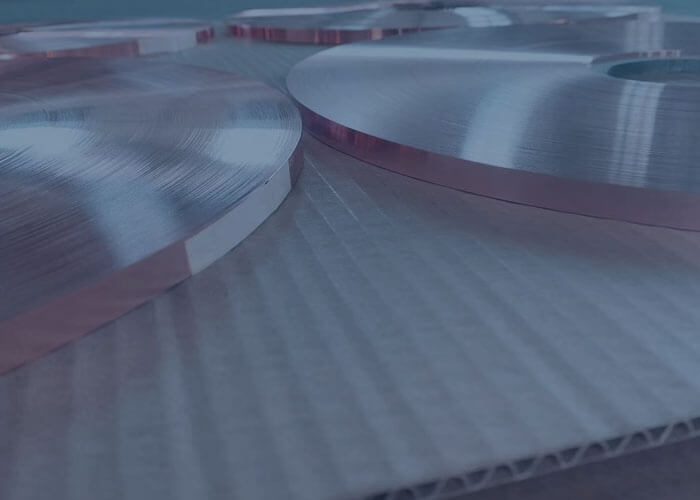Copper is one of the most widely used materials for manufacturing electrical appliances and more conductive applications.
This alloy is known for minimum energy losses and very effective thermal conductivity during heat transfer.
The thermal conductivity of copper is 413 W/m-K, which is the second highest of all the metals. The colour of copper metal is reddish brown, which distinguishes it from other metals.
Copper is an outstanding heat and electricity conductor, only surpassed by silver in both cases. This quality is connected to its atomic structure, in which each copper atom is packed close to each other, allowing electrons to move very easily between nearby atoms. Its exceptional thermal conductivity is derived from the movement of electrons.
Due to its excellent thermal conductivity, copper is used in many applications like hot water pipes, motor windings, and car radiators.

What Do You Mean By Thermal Conductivity?
The ability of a material to conduct or transfer heat from one end to another end is called thermal conductivity. The thermal conductivity is represented with λ or k; this coefficient shows the strong or weak insulation and preservation. The symbol of thermal conductivity is k, and the unit of conductivity is W/m-K (Watts per meter Kelvin). The thermal conductivity of a material is a measure of how effectively it transfers heat.
Thermal conductivity is an important factor in determining conductive heat transmission. Heat can transfer through three channels: conduction, convection, and radiation. The heat transmission process is accomplished when there is a temperature difference between two specific places; all heat transmission happens; conduction differs in that the heat passes through the body of the substance. Convection is non-existent within solids, and radiation is generally insignificant, so conduction is essential for explaining thermal dynamics.
Thermal conductivity is a physical property; therefore, it may vary on the material’s type, structure, and state. Similarly, it is a function of temperature, which is essential to remember in applications where temperature might fluctuate substantially, such as electronic thermal control systems.
The metals have different thermal conductivity due to the scattered mobility of electrons in the metallic bonding. As a result, metals heat up faster than other materials, such as plastics or glass.
What Do You Mean By The Thermal Conductivity Of Copper?
Copper is the metal with the second-highest electrical conductivity among all metals. If you’re asking which metal is at the top, the answer is silver, although silver wiring isn’t used in electrical applications. Aside from being significantly more expensive, silver does not possess copper’s other desirable properties like as ductility and malleability.
As a result, copper is the preferred material for the vast majority of applications needing electrical and thermal conductivity. Metals having higher heat conductivity will, predictably, have higher electrical conductivity.
Therefore, copper has excellent electrical conductivity and is most widely used in electricity transmission wires and other electrical appliances, especially in heavy-duty motors.
Copper corrodes slowly and has a high melting point. Copper is claimed to be an effective metal for minimizing energy loss during thermal conductivity.
Copper’s conductive characteristics are used in appliances such as automobile radiators, hot water pipes, metal pans, and so on. Copper is well-known for its ability to transmit electricity and heat. This occurs because delocalized electrons within metal solid lattices have the flexibility to travel freely within their lattice.
These would operate as heat and electric charge transporters from one end to the other, converting the metals into excellent conductors. Copper is well-known for its corrosion resistance, electric conductivity, antibacterial qualities, recyclable nature, and thermal conductivity. However, the thermal conductivity of copper is the most important and prominent of the rest of all.
Different Methods To Test Out The Thermal Conductivity Of Copper
Generally, there are two basic methods for testing the thermal conductivity of copper: the steady-state method and the non-steady-state or transient method.
Steady-state Method
In general, steady-state approaches measure when the material’s temperature is constant, and the observed temperature does not change over time. As a result, signal analysis is simple (steady-state signals imply continuous signals). The sole disadvantage is that a well-designed experimental setup is usually required.
When the thermal state of a tested material reaches perfect equilibrium, the steady-state technique records a measurement. The negative aspect is that it usually takes a long time to achieve the desired balance. Because a well-designed experimental installation system is frequently required, the method offers costly method apparatus. However, it is the fundamental and most accurate method of measuring.
Transient Methods
The method which records the measurements during the heating process is called the transient or non-steady method for testing the thermal conductivity of copper. Thermal conductivity parameters are determined using transient sensors in this method.
In this method, the measurements can be obtained quickly, giving them an advantage over steady-state methods. As a result, several solutions to the transient heat conduction equation have been found using one, two, and three-dimensional geometries. Needle probes or wires are commonly used for results in transient procedures.
Applications of Thermal Conductivity of Copper
Due to its outstanding thermal conductivity, corrosion resistance, durability and electrical conductivity, copper metal is used in many applications. Some key applications of copper are given below:
Heat exchangers
Copper is widely used in heat exchangers in air conditioning, industrial buildings, hot water tanks, underfloor heating systems, and refrigeration.
Electrical wires
Due to its great thermal and electrical conductivity, copper is widely used in electrical wiring. It effectively conducts heat away from the wires, reducing overheating and maintaining electrical performance.
Cooking utensils and heat sinks
Copper is an excellent material for decreasing energy loss during heat transmission. As a result, it is mostly used to manufacture a wide range of items, including saucepans, hot water pipes, and electronic heat sinks.
Transformer winding

Copper foils strips for transformers are the electrical industry’s most versatile materials, and has important advantages for winding transformer conductors.
Copper foil strip is made by rolling copper to a very thin thickness (between 0.0015mm and 0.3mm) and then cold-rolling or hot rolling depending on the required thickness. This can be followed by annealing (for even greater flexibility) and further processed into strips or laminated sheets with insulation materials.
Conclusion
Copper and its alloys play a vital role in industrial requirements as well as domestic needs due to its excellent thermal conductivity.
We have many years of experience in dealing with pure copper strips and foils.
Our staff will guide you about everything about your project related to the thermal conductivity of copper and its alloys.












